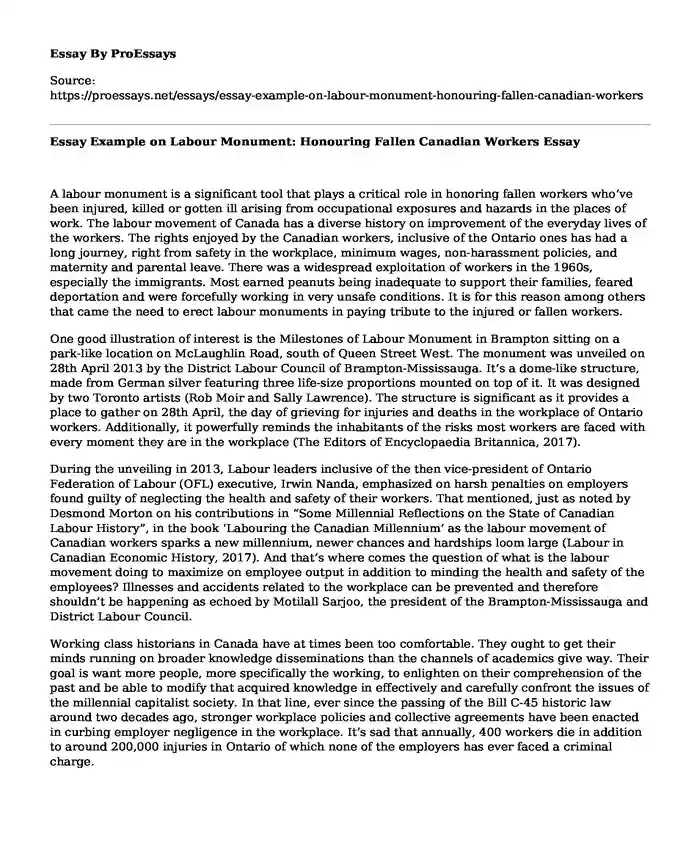A labour monument is a significant tool that plays a critical role in honoring fallen workers who’ve been injured, killed or gotten ill arising from occupational exposures and hazards in the places of work. The labour movement of Canada has a diverse history on improvement of the everyday lives of the workers. The rights enjoyed by the Canadian workers, inclusive of the Ontario ones has had a long journey, right from safety in the workplace, minimum wages, non-harassment policies, and maternity and parental leave. There was a widespread exploitation of workers in the 1960s, especially the immigrants. Most earned peanuts being inadequate to support their families, feared deportation and were forcefully working in very unsafe conditions. It is for this reason among others that came the need to erect labour monuments in paying tribute to the injured or fallen workers.
One good illustration of interest is the Milestones of Labour Monument in Brampton sitting on a park-like location on McLaughlin Road, south of Queen Street West. The monument was unveiled on 28th April 2013 by the District Labour Council of Brampton-Mississauga. It’s a dome-like structure, made from German silver featuring three life-size proportions mounted on top of it. It was designed by two Toronto artists (Rob Moir and Sally Lawrence). The structure is significant as it provides a place to gather on 28th April, the day of grieving for injuries and deaths in the workplace of Ontario workers. Additionally, it powerfully reminds the inhabitants of the risks most workers are faced with every moment they are in the workplace (The Editors of Encyclopaedia Britannica, 2017).
During the unveiling in 2013, Labour leaders inclusive of the then vice-president of Ontario Federation of Labour (OFL) executive, Irwin Nanda, emphasized on harsh penalties on employers found guilty of neglecting the health and safety of their workers. That mentioned, just as noted by Desmond Morton on his contributions in “Some Millennial Reflections on the State of Canadian Labour History”, in the book ‘Labouring the Canadian Millennium’ as the labour movement of Canadian workers sparks a new millennium, newer chances and hardships loom large (Labour in Canadian Economic History, 2017). And that’s where comes the question of what is the labour movement doing to maximize on employee output in addition to minding the health and safety of the employees? Illnesses and accidents related to the workplace can be prevented and therefore shouldn’t be happening as echoed by Motilall Sarjoo, the president of the Brampton-Mississauga and District Labour Council.
Working class historians in Canada have at times been too comfortable. They ought to get their minds running on broader knowledge disseminations than the channels of academics give way. Their goal is want more people, more specifically the working, to enlighten on their comprehension of the past and be able to modify that acquired knowledge in effectively and carefully confront the issues of the millennial capitalist society. In that line, ever since the passing of the Bill C-45 historic law around two decades ago, stronger workplace policies and collective agreements have been enacted in curbing employer negligence in the workplace. It’s sad that annually, 400 workers die in addition to around 200,000 injuries in Ontario of which none of the employers has ever faced a criminal charge.
Conclusion
Lots of Canadians put a lot of effort daily in minimizing accidents and incidents. However, it can’t be denied that risk is an inherent aspect in most places of work, and that’s why labour federations emphasize on observing safety as one of the fundamental values in any one given place of work. That said, it is with no doubt that the monument and the Mourning Day deserve celebration as done on every 28th April in Canada. The essentiality of comprehending ourselves by way of in-depth analysis of our history and paying tribute to the fallen workers by erecting monuments is what unites us. Additionally, having the annual celebrations enhances in instilling courage into the workers and a boosts their psych every day in the workplace knowing well their health and safety isn’t at stake.
References
Klee, M. (2000). Fighting the Sweatshop in Depression Ontario: Capital, Labour and the Industrial Standards Act. Labour / Le Travail, 45, 13. doi:10.2307/25149042
Labour in Canadian Economic History. (2017). Essays in Canadian Economic History, 176-199. doi:10.3138/9781487512590-014
The Editors of Encyclopaedia Britannica. (2017, May 02). Canadian Labour Congress. Retrieved July 28, 2020, from https://www.britannica.com/topic/Canadian-Labour-Congress
Cite this page
Essay Example on Labour Monument: Honouring Fallen Canadian Workers. (2023, Oct 27). Retrieved from https://proessays.net/essays/essay-example-on-labour-monument-honouring-fallen-canadian-workers
If you are the original author of this essay and no longer wish to have it published on the ProEssays website, please click below to request its removal:
- Basquiat, Da Vinci and Sor Juana Paper Example
- Jacob Lawrence Biography Paper Example
- Essay Sample on Progressivism: The Quest for a Better America in the Era of Theodore Roosevelt
- Research Paper on US-German-British Alliance: A Turning Point in WW2
- Revolution in Canada: Burke & Locke's Viewpoints - Essay Sample
- U.S. Becomes More Open, Tolerant, and Free in the 1960s - Essay Sample
- Migration in Europe - Research Paper Sample







